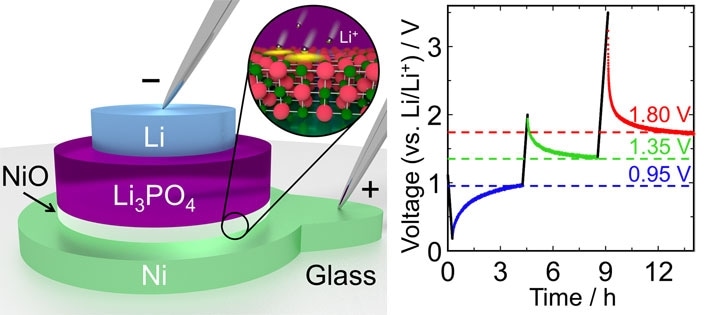Nov 25 2019
Drawing inspiration from solid lithium-ion batteries, a team of researchers from the Tokyo Institute of Technology (Tokyo Tech) and the University of Tokyo (UTokyo) have designed a new three-valued memory device.
 Design of the layered three-valued memory cell. The stacked layers in the proposed memory device form a mini-battery that can be quickly and efficiently switched between three different voltage states (0.95 V, 1.35 V, and 1.80 V). Image Credit: Tokyo Institute of Technology.
Design of the layered three-valued memory cell. The stacked layers in the proposed memory device form a mini-battery that can be quickly and efficiently switched between three different voltage states (0.95 V, 1.35 V, and 1.80 V). Image Credit: Tokyo Institute of Technology.
The proposed device consumes very low energy and could be the solution to create faster and more energy-efficient random-access memories (RAMs), which are widely used in modern computers.
Almost all digital devices that carry out any sort of information processing need not just a processing unit, but also a quick memory that can store the inputs, partial results, and outputs of the operations carried out, temporarily. In computers, this memory is called dynamic random-access memory (DRAM). The speed of DRAM is highly significant and can have a substantial effect on the total speed of the system.
Furthermore, limiting the energy consumption of memory devices has of late become a popular topic to realize extremely energy-efficient computing. Thus, many research works are paying attention to testing out new memory technologies to surpass the performance of the traditional DRAM.
Memory cells are the most basic units in a memory chip. Each cell normally stores a single bit by adopting and holding one of two probable voltage values, which match with a stored value of either “0” or “1.” The properties of the individual cell mostly govern the performance of the complete memory chip. Simpler and smaller cells with high speed and low energy consumption would be perfect to take extremely efficient computing to a higher level.
Recently, a team of researchers from Tokyo Tech headed by Prof. Taro Hitosugi and student Yuki Watanabe realized a new milestone in this study area. The researchers had earlier built an innovative memory device, with inspiration from the design of solid lithium-ion batteries. It included a stack of three solid layers composed of gold, lithium, and lithium phosphate.
This stack is fundamentally a tiny low-capacity battery that works as a memory cell; it can be rapidly switched between charged and discharged states that signify the two possible values of a bit. However, gold can be integrated with lithium to form a thick alloy layer, which increases the energy needed to change from one state to the other.
In the new study, the team developed a similar three-layer memory cell using nickel rather than gold. They anticipated better results using nickel as it does not easily form alloys with lithium, which would result in lower energy consumption when switching. The memory device they built was way better than the earlier one; it could typically hold three different voltage states rather than two, implying that it is a three-valued memory device.
This system can be viewed as an extremely low-capacity thin-film lithium battery with three charged states.
Taro Hitosugi, Professor, Department of Chemical Science and Engineering, Tokyo Institute of Technology
This is a highly remarkable feature with possible advantages for three-valued memory implementations, which could save the required area.
The scientists also learned that nickel develops a very thin nickel oxide layer between the Ni and the lithium phosphate layers. This oxide layer is vital for the low-energy switching of the device. The oxide layer is a lot thinner than that of the gold–lithium alloys that formed in their earlier device, which means that this new “mini-battery” cell’s capacity is very low and is thus quickly and easily swapped between states by applying very little current.
The potential for extremely low energy consumption is the most noteworthy advantage of this device.
Taro Hitosugi, Professor, Department of Chemical Science and Engineering, Tokyo Institute of Technology
Lower energy consumption, increased speed, and smaller size are features much in demand for future memory devices. The memory cell created by this team is a potential stepping stone toward considerably faster and more energy-efficient computing.